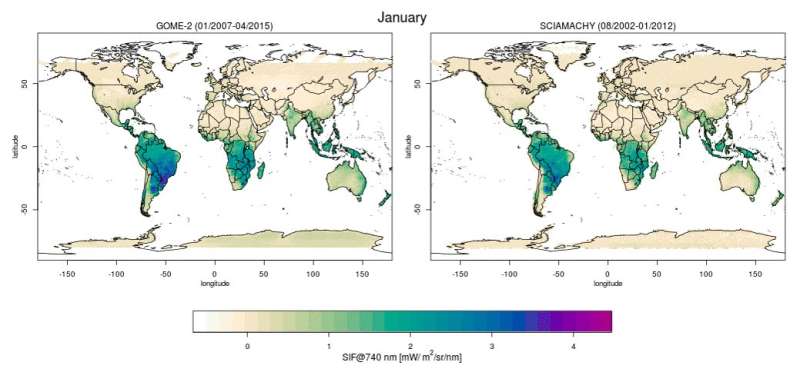Satellites map photosynthesis at high resolution

Life on Earth is impossible without photosynthesis. It provides food and oxygen to all higher life forms and plays an important role in the climate system, regulating the uptake of carbon dioxide (CO2) from the Earth's atmosphere and its fixation in biomass. However, quantification of photosynthesis at the ecosystem-to-global scale remains uncertain.
Now, an international team of scientists has made a major step forward. They used data of NASA's Orbiting Carbon Observatory 2 (OCO-2) to map the so-called solar-induced chlorophyll fluorescence (SIF) at a much higher spatial resolution than possible from any other space instrument. The weak but nevertheless detectable SIF signal emerges naturally on sunlight-exposed leaves, when chlorophyll molecules are excited by absorbed photons, and is a proxy for plant photosynthesis. These measurements will improve the understanding of the global carbon cycle, concludes Ying Sun from NASA's Jet Propulsion Laboratory in Pasadena and colleagues. They have published their results in the journal Science.
The main strength of the SIF measurements from OCO-2 is their very high spatial resolution. "Until the launch of the OCO-2 satellite mission in 2014, we had global maps of SIF, but at coarse spatial resolution, each pixel comprising areas of about 50 x 50 kilometres in the best case," says Luis Guanter from GFZ. The new data, which were extensively validated by independent measurements on the ground, are much richer. "They allow us to look into relationships between SIF and the gross primary production (GPP)—the amount of carbon fixed by plants through photosynthesis—at scales never explored before."
The authors found that one single linear relationship can be used to scale SIF to GPP across different vegetation types such as crops, forests and grasslands, which contradicts previous findings obtained with low-resolution data. This offers an exciting topic for further research. "Precise measurement of the solar-induced chlorophyll fluorescence, derived from OCO-2—but also from follow-on missions such as the European Sentinel-5P, which will be launched on October 13th—enables scientists to quantify gross primary production and its contribution to the global carbon cycle," says Guanter.
"With such improved satellite data, we can for the first time combine global SIF observations with in-situ ecosystem scale data of gross carbon uptake. This has great potential to improve our global data-driven estimates of photosynthesis and other fluxes between land and atmosphere that are relevant for the Earth System" says Martin Jung from MPI-BGC.
More information: Y. Sun el al., "OCO-2 advances photosynthesis observation from space via solar-induced chlorophyll fluorescence," Science (2017). science.sciencemag.org/cgi/doi … 1126/science.aam5747
Journal information: Science
Provided by Helmholtz Association of German Research Centres





















